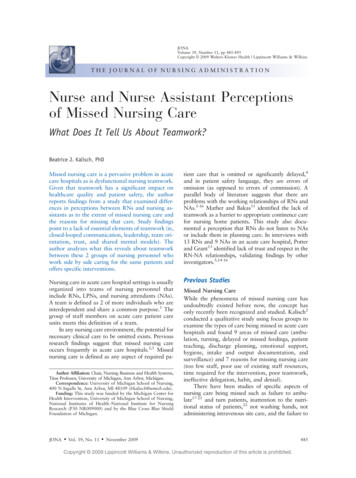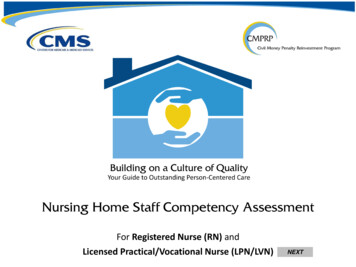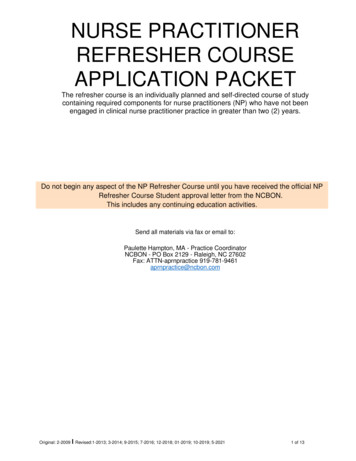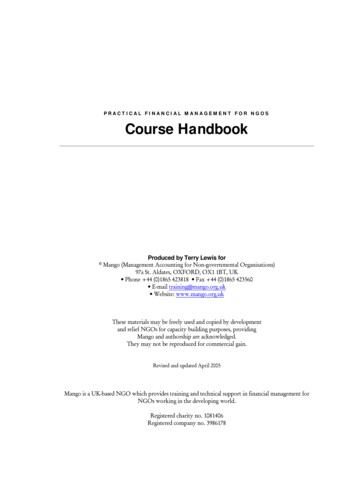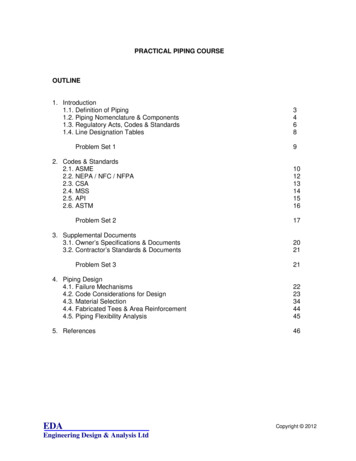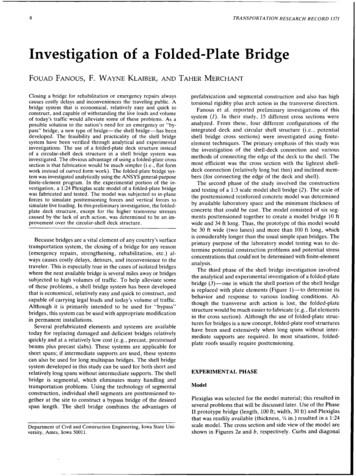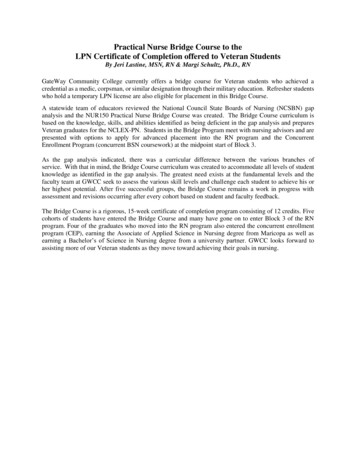
Transcription
Practical Nurse Bridge Course to theLPN Certificate of Completion offered to Veteran StudentsBy Jeri Lastine, MSN, RN & Margi Schultz, Ph.D., RNGateWay Community College currently offers a bridge course for Veteran students who achieved acredential as a medic, corpsman, or similar designation through their military education. Refresher studentswho hold a temporary LPN license are also eligible for placement in this Bridge Course.A statewide team of educators reviewed the National Council State Boards of Nursing (NCSBN) gapanalysis and the NUR150 Practical Nurse Bridge Course was created. The Bridge Course curriculum isbased on the knowledge, skills, and abilities identified as being deficient in the gap analysis and preparesVeteran graduates for the NCLEX-PN. Students in the Bridge Program meet with nursing advisors and arepresented with options to apply for advanced placement into the RN program and the ConcurrentEnrollment Program (concurrent BSN coursework) at the midpoint start of Block 3.As the gap analysis indicated, there was a curricular difference between the various branches ofservice. With that in mind, the Bridge Course curriculum was created to accommodate all levels of studentknowledge as identified in the gap analysis. The greatest need exists at the fundamental levels and thefaculty team at GWCC seek to assess the various skill levels and challenge each student to achieve his orher highest potential. After five successful groups, the Bridge Course remains a work in progress withassessment and revisions occurring after every cohort based on student and faculty feedback.The Bridge Course is a rigorous, 15-week certificate of completion program consisting of 12 credits. Fivecohorts of students have entered the Bridge Course and many have gone on to enter Block 3 of the RNprogram. Four of the graduates who moved into the RN program also entered the concurrent enrollmentprogram (CEP), earning the Associate of Applied Science in Nursing degree from Maricopa as well asearning a Bachelor’s of Science in Nursing degree from a university partner. GWCC looks forward toassisting more of our Veteran students as they move toward achieving their goals in nursing.
Board Approved 09/27/2013Veteran’s/LPN Bridge Course8 didactic credits (120 hours); 4 lab/simulation/clinical/Pharm/IV credits (180 hours)Total of 12 credits/300 clock hoursCourse Description:Designed to bridge previously gained healthcare knowledge, skills, and abilities of the military Veteran studentto the role of the practical nurse. Course includes didactic, laboratory, and clinical experiences for practicalnursing including concepts and theories related to care of geriatric, adult, pediatric, and childbearing clients.Areas of didactic and clinical focus include: role of the practical nurse collaborating with other members of thehealthcare team; concepts of health promotion and disease/illness prevention; therapeutic communicationtechniques; nutritional concepts; medication administration to include pharmacokinetics and pharmacodynamicsof medications, nursing considerations in medication administration, and dosage calculation; anatomy andphysiology and pathophysiologic concepts, documentation and concepts related to information technology.Emphasis in clinical practicum is on nursing care of pediatric and child-bearing families, and older adultresidents of long term care facilities with selected alterations in health; concepts of delegation, prioritization andmanagement of care for the practical nurse is integrated.Need statement:Under House Bill 2076, passed February 2013, this course meets the “bridge course” requirement for a Veteran,who has completed a military program of basic medical training and was awarded a military occupationalspecialty. Based on analysis of military education (National Council of State Boards of Nursing, 2013), militaryspecialist program graduates received some, but not all, the education and skills equivalent to a licensedpractical nurse. This course meets the Arizona State Board of Nursing requirements for a “bridge course” tofill the gaps between the Veteran’s military education and experience and license practical nursing educationalrequirements.Purpose statement:Develop a statewide bridge course/pathway based on the gap analysis for the military veteran trained in themedical field to articulate into a practical nursing bridge course and continue on the pathway to an associatedegree in nursing, a bachelor’s degree in nursing, and beyond.Eligibility:A person who has completed military health care training to include but not limited to: Basic MedicalTechnician Corpsman Program (Navy and Air Force), Air Force Independent Duty Medical Technician, ArmyHealth Care Specialist.Course Competencies1) Identify differences between current military healthcare role and practical nursing.2) Demonstrate therapeutic communication skills and caring behaviors to clients and theirfamilies across the lifespan.3) Demonstrate critical thinking skills and problem-solving to provide holistic nursing careto clients.4) Identify types, classifications, pharmacokinetics, and pharmacodynamic properties ofselected drugs.5) Apply principles of safe medication administration for childbearing, pediatric, adult, andgeriatric clients.6) Perform data collection techniques for childbearing, pediatric, adult, and geriatric clients.
Board Approved 09/27/20137) Implement the established plan of care for childbearing, pediatric, adult, and geriatricclients.8) Apply anatomy and physiology, and pathophysiologic concepts to the care of clients withselected health alterations across the lifespan.9) Apply integrated nutritional concepts that support health promotion and diseaseprevention to clients across the lifespan.10) Identify developmental stages and transitions for adult, child-bearing, pediatric, andgeriatric clients.11) Demonstrate safe techniques and competent care in providing interventions for clientsreceiving intravenous therapy.12) Calculate medication dosages safely and accurately.13) Practice within the regulatory, legal and ethical frameworks of practical nursing.14) Demonstrate safe performance of selected clinical skills/procedures.15) Communicate significant client findings and events to the registered nurse and othermembers of the healthcare team.16) Demonstrate culturally sensitive care.17) Describe the role of the practical nurse in the management of a group of clients under thedirection of a registered nurse using time management, interpersonal communication,delegation and organizational skills.18) Apply elements of technology and information management to document and reportclient findings and conditions.19) Demonstrate safe and competent care in providing nursing interventions for clients acrossthe lifespan.20) Identify various healthcare roles that are part of the healthcare team and differentiate theLPN role as defined by the Arizona State Board of Nursing.Course Outline – Recommended sequencing of content; final content sequencing to be determined byinstructional faculty.I.Critical ThinkingA. Nursing ProcessB. Data Collection1. Components of a Health History2. Full vs. Focused AssessmentC. PlanningD. ImplementationE. EvaluationF. Documentation1. Electronic Medical RecordG. Caring for the Pediatric/Adult/Geriatric and Childbearing Patient1. Therapeutic CommunicationII. Role DevelopmentA. Role transition from Veteran healthcare worker to the role of the Practical NurseB. Collaboration within the Health Care Team1. Communication2. Conflict Resolution3. Delegation4. Role in Patient Education and Discharge PlanningC. Scope of Practice1. Standards of Practice for the Practical Nurse2. State Nurse Practice Act
Board Approved 09/27/20133. Agency Specific GuidelinesD. Legal and Ethical Considerations in Patient CareE. Licensure Process1. National Council Licensure Examination2. State Board of NursingF. Transition into Employment Sector1. Professional appearance2. Professional communication3. Resumes4. Interview skillsIII. HolismA. Religious and Spiritual ConsiderationsB. Cultural ConsiderationsC. Developmental Life Span Considerations1. Stages of Growth and Development for Pediatric/Adult/Geriatric and Childbearing PatientsD. Health Promotion and Disease Prevention for Pediatric/Adult/Geriatric and Childbearing PatientsIV. Safe Nursing PracticeA. Nursing Care of Adult/Geriatric/Pediatric Patients with Select Alterations in Health,Anatomy/Physiology/Pathophysiology, Applicable Laboratory and Diagnostic Examinations, MedicalManagement, Nursing Process, Pharmacokinetics and Pharmacodynamics of Applicable MedicationClassifications1. Disorders of the Cardiovascular and Peripheral Vascular System2. Disorders of the Respiratory System3. Disorders of the Gastrointestinal System4. Disorders of the Endocrine System5. Disorders of the Immune System6. Disorders of the Integumentary System7. Disorders of the Hematologic and Lymphatic System8. Disorders of the Reproductive System9. Disorders of the Musculoskeletal System10. Disorders of the Genitourinary System11. Disorders of the Neurologic System12. Fluid/Electrolyte and Acid/Base Imbalances13. Cancer14. Mental Health Disordersa. Behavior Managementb. Crisis Intervention15. Surgical Patienta. Preoperativeb. Intraoperativec. PostoperativeB. Nursing care of the Antepartum Patient and FamilyC. Nursing Care of the Intrapartum Patient and FamilyD. Nursing Care of the Postpartum Patient and FamilyE. Nursing Care of the NeonateV. Selected Clinical Skills/Therapeutic ProceduresA. Assisting with Activities of Daily Living1. Feeding2. Dressing3. Bathing4. Positioning
B.C.D.E.F.G.H.I.J.K.L.M.N.O.P.Q.R.S.T.Board Approved 09/27/20135. Ambulating and Transferring Patients6. Toileting7. GroomingVital SignsInternal and External Disaster PlanningHandling Hazardous and Infectious MaterialsErgonomic PrinciplesUse of Restraint and Safety DevicesAdmission/Transfer/Discharge ProceduresWound CareHeat/Cold TherapyOxygen TherapyUrinary CatheterOstomyNasogastric/Feeding TubeChest TubeCare of the Patient Receiving a Blood TransfusionTracheostomyElectrocardiogram/Cardiac MonitoringWound CareMedication Administration1. Medication Orders2. Drug Preparations3. Dosage Calculations4. Preparation of Medications5. Medication Administration Methods6. DocumentationIntravenous Infusion Therapy/Venipuncture1. Scope of the Practical Nursea. Arizona State Board of Nursingb. Legal Implicationsc. Documentation2. Blood Collection3. Principles of IV Therapya. Routine Care and Maintenanceb. Catheter Site Carec. Flushing with Saline or Heparinized Salined. Client Evaluatione. Equipment4. Complications/Adverse Reactionsa. Localb. Mechanicalc. Systemic5. Insertion of Peripheral-Short IV Catheters6. Discontinuation of Peripheral IV Cathetersa. Peripheral-Shortb. Peripheral Midline7. Pharmacokinetics/Pharmacodynamics for Select IV Fluids and Medicationsa. Hypo-/Iso-/Hypertonic Solutionsb. Premixed/Admixture Medications8. Dosage Calculations/Regulating Rates9. Administration of Select Intravenous Solutionsa. Un-medicated Solutionsb. Premixed/Admixed Medications
Board Approved 09/27/201310. Care and Maintenance of Central LineU. Clinical Skills/Therapeutic Procedures for the Child-Bearing Client/Family/Neonate1. Data Collection2. Use of Isolette/WarmerV. Clinical Skills/Therapeutic Procedures for the Pediatric Client1. Data Collection2. Medication AdministrationSuggested Lab and clinical hours:40 hours long term care/acute care25 hours pediatric25 hours OB45 hours lab/simulation45 hours for IV/Pharm
LPN Certificate of Completion offered to Veteran Students . GateWay Community College currently offers a bridge course for Veteran students who achieved a credential as a medic, corpsman, or similar designation through their military education. Refresher students . Students in the Bridge
